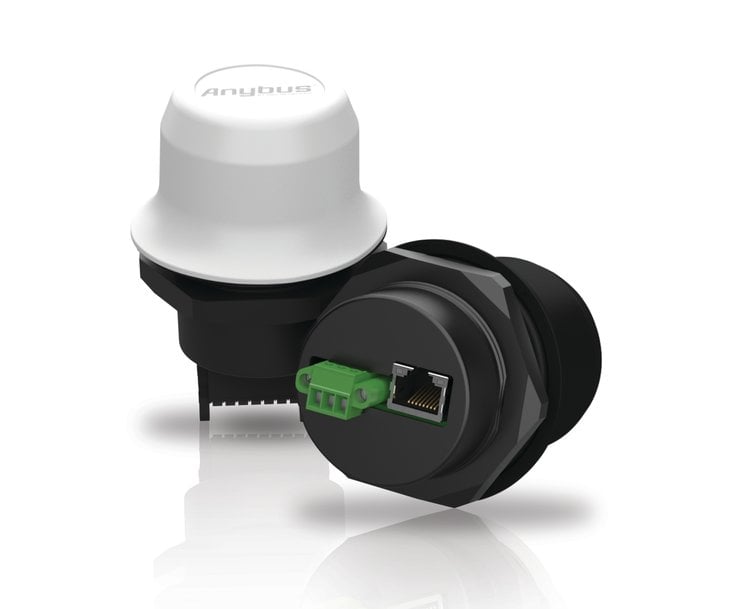www.ptreview.co.uk
20
'20
Written on Modified on
Cellular internet connectivity for remote assets with the robust Anybus Wireless Bolt IoT
HMS Networks announces the release of Anybus® Wireless Bolt IoT which enables reliable cellular-based internet connectivity for assets in the field, using the new LTE-based networks NB-IoT and CAT-M1.

Companies are increasingly looking to connect remotely located assets for remote monitoring and control over the internet. However, many times there is no local infrastructure available to connect such assets to the internet in a traditional way. The Anybus Wireless Bolt IoT by HMS Networks targets this very situation, providing reliable cellular-based internet connectivity over NB-IoT and CAT-M1 for remote assets that are otherwise hard to reach and connect.
Cellular connectivity with Wireless Bolt IoT bolted onto remote assets
Wireless Bolt IoT includes all elements needed to get stationary or mobile assets online over a cellular connection. Packaged in the unique Bolt format for on-asset M50 hole mounting, it features a robust IP66/IP67 housing with UL NEMA 4X certificate for outdoor mounting, an integrated cellular antenna with a modem, a microcontroller, and firewall.
Easy and transparent communication over Ethernet to the asset
A built-in Ethernet port is used to connect to a corresponding Ethernet port on the asset. The configuration is done via a built-in webserver or by sending REST commands via the Ethernet port. After this, Wireless Bolt IoT will transfer data transparently from the asset to the cellular internet connection using TCP/UDP based protocols. Power over Ethernet (PoE) is supported, but power can also be supplied via separate terminals.
NB-IoT and CAT-M1 with 2G fallback for global deployment
On the cellular link, Wireless Bolt IoT communicates using the latest LTE standards NB-IoT and CAT-M1 with 2G (GPRS/EDGE) fallback, which enables reliable deployment almost anywhere in the world. These new LTE standards are so-called LP-WAN technologies (Low Power Wide Area Network) suitable for new IoT use cases that typically require low power consumption, low bandwidth (25-300 Kbit/s), good geographical coverage and a low connectivity cost per asset. An onboard SIM-card slot enables connection to any operator network worldwide. Private enterprise networking of assets is also supported using cellular Private APN networks.
Power-saving solution for battery-driven equipment
Wireless Bolt IoT is especially suitable for battery-driven assets not connected to the electric grid, such as electronic road signs, traffic metering stations, and water level measuring stations. By using its “Low Power mode”, Wireless Bolt IoT enters a low power state when data is not transferred which means that the size of the battery/power supply can be kept to a minimum.
Cellular connectivity with Wireless Bolt IoT bolted onto remote assets
Wireless Bolt IoT includes all elements needed to get stationary or mobile assets online over a cellular connection. Packaged in the unique Bolt format for on-asset M50 hole mounting, it features a robust IP66/IP67 housing with UL NEMA 4X certificate for outdoor mounting, an integrated cellular antenna with a modem, a microcontroller, and firewall.
Easy and transparent communication over Ethernet to the asset
A built-in Ethernet port is used to connect to a corresponding Ethernet port on the asset. The configuration is done via a built-in webserver or by sending REST commands via the Ethernet port. After this, Wireless Bolt IoT will transfer data transparently from the asset to the cellular internet connection using TCP/UDP based protocols. Power over Ethernet (PoE) is supported, but power can also be supplied via separate terminals.
NB-IoT and CAT-M1 with 2G fallback for global deployment
On the cellular link, Wireless Bolt IoT communicates using the latest LTE standards NB-IoT and CAT-M1 with 2G (GPRS/EDGE) fallback, which enables reliable deployment almost anywhere in the world. These new LTE standards are so-called LP-WAN technologies (Low Power Wide Area Network) suitable for new IoT use cases that typically require low power consumption, low bandwidth (25-300 Kbit/s), good geographical coverage and a low connectivity cost per asset. An onboard SIM-card slot enables connection to any operator network worldwide. Private enterprise networking of assets is also supported using cellular Private APN networks.
Power-saving solution for battery-driven equipment
Wireless Bolt IoT is especially suitable for battery-driven assets not connected to the electric grid, such as electronic road signs, traffic metering stations, and water level measuring stations. By using its “Low Power mode”, Wireless Bolt IoT enters a low power state when data is not transferred which means that the size of the battery/power supply can be kept to a minimum.
Learn more at www.anybus.com

